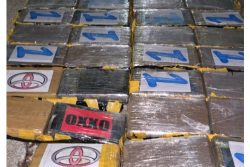In recent days, talk of the establishment of an oil refinery here has heated up as if the multiplying risks from the offshore oil platforms and the climate peril aren’t enough to deal with. When he first mentioned a modular, 30,000-barrel oil refinery in October last year, President Ali seemed to have been moved by the need to respond to the buoyant interest among investors and the need to give opportunities to the local business sector. With its billions of barrels of oil equivalent offshore, Guyana is being circled by sharks and various other predators. There is definitely no need to encourage this feeding frenzy. Investor interest and the need to advance local business opportunities are not adequate grounds to invest in toxic oil refining on terra firma. As an aside, one can imagine how many of the cronies of this government and their middlemen are salivating at the prospect of an oil refinery and trying to sway things in their direction.
At his most recent press conference, Vice President Jagdeo also entered the fray. His argument in favour of an oil refinery seemed premised on energy security i.e. taking account of the disruptions in the supply chain and transportation etc. Many have used Russia’s heinous and criminal war against Ukraine to create fears about the oil supply chain in an era where the writing is on the wall for carbon fuels. One definitely does not have to invest in an oil refinery for energy security. It is impossible to conceive of a circumstance where Guyana would be unable to access refined fuels for its needs particularly as its much vaunted Low Carbon Development Strategy should be moving it inexorably in the direction of less and less dependence on carbon fuels.
Even so, if Mr Jagdeo and his government are so worried about supply chain disruptions, perhaps they could begin looking at other possibilities that would be free of the toxicities inherent in a refinery. For example, the government here, with the agreement of the opposition, could consider the creation of a Strategic Petroleum Reserve (SPR) in line with the model adopted by the United States. The SPR was initiated during the 1973 to 74 Arab oil embargo against the US and others. Oil is stored in underground tanks and the SPR is said to have the capacity for 714 million barrels which can keep the entire country supplied for around three weeks.
Not only would this provide energy security but at times of unduly high oil prices there is the prospect of releasing some of this onto the market at cost. Given its earnings from the oil sector – as volatile as it is – Guyana is in a good position to begin creating a petroleum reserve by progressively making acquisitions when prices are favourable. Remember, oil don’t spoil. It would, of course, task the authorities with the challenge of managing such a facility in term of security, safety and logistical concerns but that has to be far simpler than permitting a refinery that is fertile with any number of risks.
If we don’t need our own refinery we certainly shouldn’t be hosting one for the Dominican Republic (DR). Creating linkages with the thriving sectors of Santo Domingo’s economy is highly recommended. However, none of their investors would be able to pay this country enough to host a refinery to provide DR with refined fuels. That Memorandum of Under-standing that was signed by President Ali is one for a dusty bookshelf.
The October 8th 2022 editorial of this newspaper addressed the continuing financial infeasibility of a refinery.
In 2017 Pedro Haas, Director of Advisory Services at Hartree Partners had presented the findings of whether a refinery here would be viable. He concluded it was not. “Building and operating an oil refinery is risky and requires significant capital investment,” he told local businessmen.
He was also negative about a scaled down refinery. As reported by Stabroek News, he said: “If you scale it down… If you have a very high infrastructural cost, the fact that you scaled down hurts the project instead of helping it. Because you are going to have to build docks, you are going to have to build tanks. You are going to have to build water treatment. You are going to have to build an energy facility to supply power. You are going to need steam. You are going to need all sort of ancillary facilities around the refinery to make the refinery viable. The problem you have with these massive investments is that the cost of building a refinery and the cost of building the infrastructure is not necessarily proportional. The bigger you build it the lower the unit cost,” he said.
Mr Haas added: “You can make various assumptions but we’ve made a range of assumptions and finally that gives you the cost of a grass-roots, 100,000 barrel per day, cracking refinery and we ended up with a total grass-roots cost in the neighbourhood of US$5 billion. It’s a large amount of money”.
According to the analysis, the base case for the 100,000 barrel-per-day new refinery would result in a negative rate of return to the tune of US$3 billion.
“Now that is a very significant number because if you remember the total investment is US$5 billion. That means you are destroying over half the value of your investment the day you commission your refinery. It’s a very significant value destruction impact and of course, the maximum debt leverage is very, very small,” he pointed out.
Then there is the huge risk to the environment from the various processes entailed by refining and the likelihood of severe pollution.
The US Hazardous Substance Research Centers/ South & Southwest Outreach Program sets out some of the processes entailed and the fallout:
• Separation processes: These processes involve separating the different fractions/ hydrocarbon compounds that make up crude oil based on their boiling point differences. Crude oil generally is composed of the entire range of components that make up gasoline, diesel, oils and waxes. Separation is commonly achieved by using atmospheric and vacuum distillation. Additional processing of these fractions is usually needed to produce final products to be sold within the market.
• Conversion processes: Cracking, reforming, coking, and visbreaking are conversion processes used to break down large longer chain molecules into smaller ones by heating or using catalysts. These processes allow refineries to break down the heavier oil fractions into other light fractions to increase the fraction of higher demand components such as gasoline, diesel fuels or whatever may be more useful at the time.
• Treating: Petroleum-treating processes are used to separate the undesirable components and impurities such as sulfur, nitrogen and heavy metals from the products. This involves processes such as hydrotreating, deasphalting, acid gas removal, desalting, hydrodesulfurization, and sweetening.
• Blending/combination processes: Refineries use blending/combination processes to create mixtures with the various petroleum fractions to produce a desired final product. An example of this step would be to combine different mixtures of hydrocarbon chains to produce lubricating oils, asphalt, or gasoline with different octane ratings.
• Auxiliary processes: Refineries also have other processes and units that are vital to operations by providing power, waste treatment and other utility services. Products from these facilities are usually recycled and used in other processes within the refinery and are also important in regards to minimizing water and air pollution. A few of these units are boilers, wastewater treatment, and cooling towers.
It adds that refineries are generally considered a major source of pollutants and are a major source of hazardous and toxic air pollutants such as BTEX compounds (benzene, toluene, ethylbenzene, and xylene). They are also a major source of criteria air pollutants: particulate matter (PM), nitrogen oxides (NOx), carbon monoxide (CO), hydrogen sulfide (H2S), and sulfur dioxide (SO2). Refineries also release less toxic hydrocarbons such as natural gas (methane) and other light volatile fuels and oils. Some of the chemicals released are known or suspected cancer-causing agents, responsible for developmental and reproductive problems.
Why should Guyana have to risk any of this only to allow some rapacious company to profit maximally?
Then there are the rusting hulks of mothballed refineries in the Caribbean and elsewhere. Trinidad and Tobago and St Croix are salutary examples of what happens to refineries which are inefficient, badly maintained and unprofitable when the market goes south.
Two governments here have now turned a blind eye to the plunderous and mercenary 2016 Production Sharing Agreement foisted upon the people of this country. A refinery will be another excrescence on this folly. The country doesn’t need that at all.








